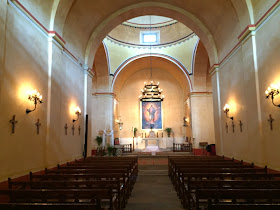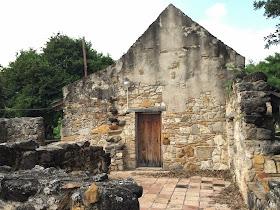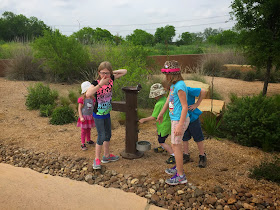In the early 1700's the missions were the only true defense against attacking Apaches, sickness, and drought. All the native Indians had to do is agree to become citizens of Spain, support the king, and accept the Catholic beliefs as their religion.
Spain wanted to keep a foothold in the area especially with the French encroachments from Louisiana and missions were a way of doing that. They were the most successful between 1745 and 1780 until increased Indian attacks, lack of sufficient military support, and disease caused their later decline.
The first mission on the San Antonio River was the Mission San Antonio de Valero or the Alamo as we know it today. It is not part of the National Park's San Antonio Missions since it is owned by the state of Texas and managed by the Daughters of the Republic of Texas.
 |
| Tia, Courtney, Ethan, Misty, Avery, Don, Chloe, and Ian in front of the Alamo. |
 | |
| Avery, Ethan, Ian, Courtney, Tia, and Chloe at Mission Concepcion. |
 |
| Mission Concepcion. |
 |
| The sanctuary for Mission Concepcion. |
 |
| One of the surviving interior wall paintings. |
 |
| Another wall painting. |
 |
| Stone quarry for Mission Concepcion and portions of Mission San Jose. |
The next mission on the river is the best known of the Texas missions, San Jose y San Miguel del Aguayo or San Jose for short.
Not only was it the biggest of all the San Antonio Missions, but was also considered to be a "model mission organization". It was a major social center, had a unique church architecture, and had prospering fields and pastures. This is why it was nicknamed, "Queen of the Missions."
 |
| Mission San Jose, the "Queen of the Missions." |
 |
| Mission San Jose. |
 |
| Another view of Mission San Jose to include the Rose Window located in the middle. |
 |
| Ethan, Chloe, Avery, Courtney, Ian, and Tia in front of the Rose Window. |
 | |||
| Mission San Jose's sanctuary. |
 |
| Grist mill at Mission San Jose. |
 |
| Back side entrance to the grist mill at Mission San Jose. |
 |
| The kids looking into a firing port at one of the bastions at Mission San Jose. |
 |
| Looking out one of the firing ports on a bastion at Mission San Jose. |
 |
| Ian, Avery, Ethan, Courtney, Chloe, and Tia at Mission San Juan. |
 |
| Mission San Juan. |
 | ||
| The sanctuary at Mission San Juan. |
 |
| Private residence for the priest at Mission San Juan. |
 |
| Some of the remaining walls still standing at Mission San Juan. |
 |
| Once of the entry ways into Mission San Juan. |
 |
| The kids favorite attraction at Mission San Juan. |
It was originally named San Francisco de los Tejas but renamed San Francisco de la Espada.
 |
| Courtney, Ethan, Avery, Ian, Chloe, and Tia at Mission Espada. |
 |
| Chloe, Tia, Courtney, Ethan, Avery, and Ian taking the Junior Park Ranger pledge. |
 |
| And to the victors go the spoils or at least the Junior Park Ranger badge. |
 |
| Church at Mission Espada. |
 |
| Church sanctuary at Mission Espada. |
 |
| Some of the fortifications on the back side of Mission Espada. |
 |
| Arches for the two centuries old Espada Aqueduct. |
 |
| Water being held in the aqueduct. |
 |
| Another view of the still working aqueduct for Mission Espada. |
 |
| Gates to control the water flow to the fields. |
 |
| The water outlet to one of the fields at Mission San Juan. |
We had a backpack with water, apples, oranges, trail mix, and Peeps left over from Easter. We decided that we would save the Peeps for the last treat once we were about a mile out in our journey to give the kids that little extra jolt of energy to finish the hike. We did not want to give it to them too early just to have them burn out with some distance still to walk.
 |
| The Riverwalk next to Mission Espada. |
 |
| Walking on the Riverwalk on the east side of the San Antonio River. |
 |
| Misty, Chloe, and Don on the Riverwalk between Mission Espada and Mission San Juan. |
 |
| A view of the San Antonio River near Mission Espada from the Riverwalk. |
 |
| Another part of the Riverwalk near Mission Espada. |
 |
| The kids getting some water at one of the many water fountains on this portion of the Riverwalk. |
 |
| The path off of the Riverwalk to the Espada Aqueduct. |
 |
| Some old mill ruins on the Riverwalk from a long lost community. |
If you are ever in San Antonio, Texas, you have to visit the mission trail and see them all for yourself. It is well worth the trip!
If you like our blog then please comment below and sign up to follow us. You can also become our friends on Facebook using the links on the upper right of this blog.
We hope you enjoyed our little view of our mission tours and do hope you make it here one day to do the same.
Once again we are so blessed by God that we can see such wonderful sights as we travel across America.
God bless and Thanks!
Don, Misty, and Kids...
 |
| States we have visited so far. |
